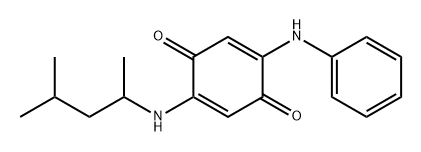| Company Name: |
Zhengzhou Anhuida Chemical Co., Ltd |
| Tel: |
+8615903659408 |
| Email: |
admin@ahdchem.com |
| Products Intro: |
Product Name:2,5-Cyclohexadiene-1,4-dione, 2-[(1,3-dimethylbutyl)amino]-5-(phenylamino)-
CAS:2754428-18-5
Purity:0.98 Package:10mg, 10g, 50g, 100g, 1kg, 5kg, 10kg
|
|
|
|
|
|
| | 6PPD-quinone Basic information |
| Product Name: | 6PPD-quinone | | Synonyms: | 2-((4-methylpentan-2-yl)amino)-5-(phenylamino)cyclohexa-2,5-diene-1,4-dione;2,5-Cyclohexadiene-1,4-dione, 2-[(1,3-dimethylbutyl)amino]-5-(phenylamino)-;2- ((4-methylpent-2-yl) amino) -5- (phenylamino) cyclohex-2,5-diene-1,4-dione;Phentolamine Impurity 31;N-(1,3-dimethylbutyl)-N′-phenyl-p-phenylenediamine quinone;2-[(1,3-dimethylbutyl)amino]-5-(phenylamino)-2,5-cyclohexadiene-1,4-dione;6PPD-Q;6PPD-quinone | | CAS: | 2754428-18-5 | | MF: | C18H22N2O2 | | MW: | 298.38 | | EINECS: | | | Product Categories: | | | Mol File: | 2754428-18-5.mol |  |
| | 6PPD-quinone Chemical Properties |
| Boiling point | 442.2±45.0 °C(Predicted) | | density | 1.12±0.1 g/cm3(Predicted) | | solubility | Acetonitrile (Slightly), Chloroform (Slightly), Ethyl Acetate (Slightly) | | form | Solid | | pka | 0.61±0.20(Predicted) | | color | Dark Orange to Dark Red | | InChI | InChI=1S/C18H22N2O2/c1-12(2)9-13(3)19-15-10-18(22)16(11-17(15)21)20-14-7-5-4-6-8-14/h4-8,10-13,19-20H,9H2,1-3H3 | | InChIKey | UBMGKRIXKUIXFQ-UHFFFAOYSA-N | | SMILES | C1(=O)C=C(NC2=CC=CC=C2)C(=O)C=C1NC(C)CC(C)C |
| | 6PPD-quinone Usage And Synthesis |
| Description | 6PPD-quinone is an oxidized derivative of the tire antiozonant and substituted p-phenylenediamine 6-PPD. It is toxic to rainbow trout (O. mykiss) and brook trout (S. fontinalis; LC50s = 0.59 and 1.96 μg/L, respectively) but not to arctic char (S. alpinus) and white sturgeon (A. transmontanus; LC50s = >12.7 μg/L for both). 6PPD-quinone (10 μg/L) induces cell death and germline DNA damage and decreases the number of mitotic cells in C. elegans gonads. Urine levels of 6-PPD-quinone are increased in pregnant women compared to non-pregnant adults and children. | | Biochem/physiol Actions | Studies have shown that 6PPD/6PPD-quinone can interact with human serum albumin (HSA). It spontaneously inserts into the I-site of HSA, forming a binary complex that induces changes in the secondary structure of HSA. However, their effects on the esterase-like activity of HSA are polarised. 6PPD activates the esterase-like activity of HSA, whereas 6PPD-quinone inhibits it. Molecular docking analyses showed that 6PPD and 6PPD-quinone interact with many amino acid residues on HSA, including TRP214, ARG222, ARG218, ALA291, and PHE211. π-electrons on the benzene ring of 6PPD/6PPD-quinone play a key role in maintaining the stability of the complex. In addition, the stronger binding affinity between 6PPD and HSA compared to 6PPD-quinone could be attributed to the greater negative surface potential of 6PPD. | | Safety | 6PPD-quinone (6PPD-q) is an oxidation product of the antioxidant N-(1,3-dimethylbutyl)-N′-phenyl-p-phenylenediamine (6PPD) present in rubber. Studies have shown that 6PPD and 6PPD- q are also present in human urine, including adults, children, and pregnant women, and that urinary 6PPD- q concentrations were significantly higher than 6PPD; pregnant women had significantly higher concentrations of 6PPD and 6PPD- q (median 0.068 and 2.91 ng/mL, respectively) than adults (0.018 and 0.40 ng/mL) and children (0.015 and 0.076 ng/mL). The high daily urinary excretion of 6PPD-Q in pregnant women was estimated to be 273 (ng/kg bw)/day. 6PPD-Q is a lethal toxicant to a wide range of aquatic species, and its potential risk to human health from long-term exposure requires urgent attention. |
| | 6PPD-quinone Preparation Products And Raw materials |
|